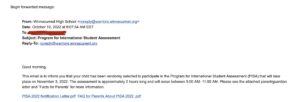Students at Winnacunnet High School may be participating in an international assessment soon. This notice was sent home to parents to see if they wanted their children to participate in the PISA international assessment. My advice on this assessment: NO WAY.

Not because I oppose an international test of knowledge, actually I’d support a test like that, but PISA is not going to tell parents how their children are competing against children in top-performing countries.
If school administrators wanted you to know how well the students were doing when it comes to their proficiency in math and science, they would be administering the TIMSS test every four years. TIMSS is an excellent achievement test in the subjects of math and science.
Let’s start with some of the glaring problems with PISA.
Many assessments are now used as a way to change your child’s values, attitudes and beliefs. You might be wondering how an assessment can do that. Shouldn’t they be asking my child how to solve a math problem? Of course, but that’s not what what’s going on here.
Let’s take a look at an example of how PISA uses their questions to push a certain political belief on children;
In this statement by PISA, they use the assessment to assess children on their “global competence.”
The Programme for International Student Assessment (PISA) is a triennial survey of 15-year-old students that assesses the extent to which they have acquired the key knowledge and skills essential for full participation in society. The assessment focuses on proficiency in reading, mathematics, science and an innovative domain. In 2018, the innovative domain was global competence.
AND
Germany
In its 2018 cycle of data collection among 15-year-old students, PISA assessed the global competences needed to live in an interconnected and changing world. Global competence is defined as a multidimensional capacity that encompasses the ability to: 1) examine issues of local, global and cultural significance; 2) understand and appreciate the perspectives and worldviews of others; 3) engage in open, appropriate and effective interactions across cultures; and 4) take action for collective well-being and sustainable development. Students in 27 countries and economies both sat the global competence test and completed the global competence module in the student questionnaire. Students in a further 39 countries and economies completed the global competence module in the questionnaire only. Students in Germany completed the questionnaire only.
This is a good time to remind everyone that a questionnaire like this must be available to parents to read on the district web site, and requires your consent.
What do they actually mean by global competence? Since this is Germany, it’s also worth considering the dire situation they are currently in based on their lack of energy resources.
PISA goes on to state:
Examine issues of local, global and cultural significance
- Students in Germany reported some of the highest levels of self-efficacy regarding global issues, scoring substantially higher than the OECD average, along with students in Albania, the Dominican Republic, Peru and the United Arab Emirates. In particular, they were the most confident when discussing the different reasons why people become refugees, with 88% saying that they could do the task easily or with some effort (OECD average 77%). Students were also very confident on explaining why some countries suffer more from global climate change than others (77%, compared to the OECD average of 72%). Students in Germany were the least confident on explaining how carbon-dioxide emissions affect global climate change (61%, compared to the OECD average of 63%) and how economic crises in single countries affect the global economy (60%, compared to the OECD average of 61%).
It appears as if the survey figures out the beliefs of children, in this case climate change, and then the next step is to include assessment questions that work to change their beliefs. That’s what many standardized assessments are all about now; changing the values, attitudes and beliefs in children.
At this age, children should be learning about science, so that if they decide to pursue a career in atmospheric sciences, they have the academic foundation. This assessment is used to push a political belief system at an early age.
The purpose of a standardized test is so parents know if their child has learned how to multiply and divide, not to be persuaded on how to view a political position.
IN: Dishonesty: A Defining Characteristic of Common Core Advocacy :
…..Unlike the other major international assessment, Trends in International Mathematics and Science Study (TIMSS), PISA focuses not on academic content knowledge but on the “skills and competencies students have acquired and can apply . . . to real-world contexts by age 15.” In other words, PISA is aligned to the same type of non-academic training embodied in the Common Core standards…..
AND
Scholars in other countries have reached the same conclusions about PISA and TIMSS. Dr. Paul Andrews of Stockholm University examined the math performance of students in Finland – a country routinely held out by the U.S. education establishment as exemplary – and found the claims of stellar performance to be misleading. Those claims, he notes, are based on PISA results.
But Finnish students’ scores on the TIMSS content-based assessments – particularly with respect to algebra and geometry –are much less impressive, so much so that Finnish mathematicians have warned that students aren’t really being prepared for higher education. “University mathematicians have voiced concerns that curricular reforms have compromised the intellectual integrity of mathematics,” Andrews reports. “They argue that emphases on equity and preparation for a world beyond school may have secured PISA success but are incompatible with preparation for higher mathematics.”
There’s more:
Jerome Dancis, PhD Associate Professor Emeritus Department of Mathematics University of Maryland College Park, MD
From Dr. Dancis’ commentary which begins on page 31:
What Does the International PISA Math Test Really Tell Us?“The results suggest that PISA is not a valid measure of the overall quality of mathematics achievement in a country. PISA mathematics largely avoids measuring Arithmetic calculations.”
On page 32 :
The December 18, 2013 New York Times editorial, “Why Other Countries Teach Better: Three Reasons Students Do Better Overseas,” discussed the findings of the 2013 PISA report. The author argues that, “… Finland has for years been in the highest global ranks in literacy and mathematical skills.” “…[Finnish] schools stand out in several ways, providing daily hot meals; health and dental services; psychological counseling; and an array of services for families and children in need.” “… But the most important effort has been in the training of teachers,” “… The country decided to move preparation out of teachers’ colleges and into the universities, where it became more rigorous.”As a Finnish university professor noted, “PISA test items are measuring the achievements of everyday life mathematics … [with no need for students] to learn mathematics as a structure. We do know in Finland that we wouldn’t get any success in PISA, if the test items were related to the understanding of mathematical concepts or relations.”Finnish college faculty complain about the low knowledge of arithmetic and simple Algebra of Finnish college students. …Is PISA valid? This question is rarely asked. The data suggest it is not a valid measure of overall mathematical ability or the quality of an education at the national level. (Page 40)
From: Wayne Bishop/ wbishop@exchange.calstatela.ed
Date: October 30, 2015As the author intimates (and I’m speaking only for mathematics), TIMSS is alive and well (housed at Boston University) and remains a more reliable assessment of mathematics achievement. At 4th and 8th grades, the US has moved up well above highly publicized Finland (using PISA) although still far behind the high-performing Asian nations……. Nothing summarizes the situation as well as the finish mathematicians and engineers themselves:
“in fact the mathematical knowledge of new students has declined dramatically”
http://solmu.math.helsinki.fi/2005/erik/PisaEng.html
Clearly those working in the field of mathematics do not share an admiration for PISA but instead, they recommend the TIMSS test. Why would school administrators use a flawed international assessment when we know the TIMSS is a far better way to determine how children are competing against their international peers? That’s a question to ask of your school administrators. If they truly want to be honest with parents, skip the PISA and administer the TIMSS test. If your school administrators refuse, then maybe there is something more to all of this.
When those in Finland do not have confidence in this assessment, why would so many administrators have confidence?
We pay Superintendents six figure salaries, it’s time to start demanding quality in our public schools.


